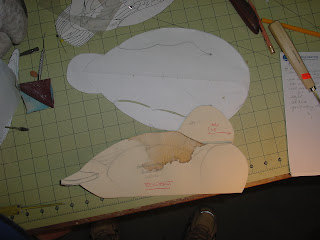It seems when a duck turns its head, there is a lot that goes on with those 17 vertebrae compared with the 5 vertebrae we humans have. Early in my carving journey I was told that if you limited the amount of head turning you did with a pose to + or - 7 degrees, you didn't need to worry about the changes to the neck, head and breast that go on compared with if you go beyond 7 degrees.
Over the past few years, I have found that 7 degrees has been pretty restrictive when it comes to trying to do more lifelike poses. The opportunity then and before I do the carving of the pair, was to learn more about anatomy and about what happens to the head, neck and breast of a bird when you step over the 7 degree line.
My good friend and carving buddy Tom, who is a part time taxidermist, has been encouraging me to learn more about this as well. A couple of weeks ago he showed up with a huge book on duck taxidermy and several articles on the subject that he had clipped from some taxidermy magazines. (Amazing isn't it...in America you can find books and magazines on darn near anything!)
 |
| A page from one of Tom's clippings. |
I put them on my table next to my collection of Canvasback reference pictures. Recall, in an early post I showed some reference pictures of Canvasback hens. One of those showed a group of Canvasbacks sleeping and that photo has been pulling on me for some time. I've only ever carved one sleeper in 2003 and luck was on my side because I certainly had no anatomical knowledge of what I was doing.
This lead me to addressing two problems. The first was to do a quick sleeper Canvasback Hen to see if I could forget this tug of if this pose and if it might prevail over the relaxed mid height head one that I was heading towards. The second, was to study and learn about twisting the head beyond 7 degrees. Certainly, doing a sleeper was an extreme turn and that I had better learn what really happens to be able to pull this off.
This lead me to addressing two problems. The first was to do a quick sleeper Canvasback Hen to see if I could forget this tug of if this pose and if it might prevail over the relaxed mid height head one that I was heading towards. The second, was to study and learn about twisting the head beyond 7 degrees. Certainly, doing a sleeper was an extreme turn and that I had better learn what really happens to be able to pull this off.
After reading and re reading the articles and making some sketches from photos, I modified a pattern to create a sleeper.
 |
| Front view.. Check out how the front on the bird is rounded with the left side ( right side of bird) being slightly higher than the other side. This is where the neck accumulates as well. |
In addition, I concluded that a sleeper in the pair competition was not to be for me. While the bird is pretty, a bird that is semi asleep (and a bit bored looking) will not fare as well with the judges as one that is more alert and has her shaped eyes fully open.


No comments:
Post a Comment